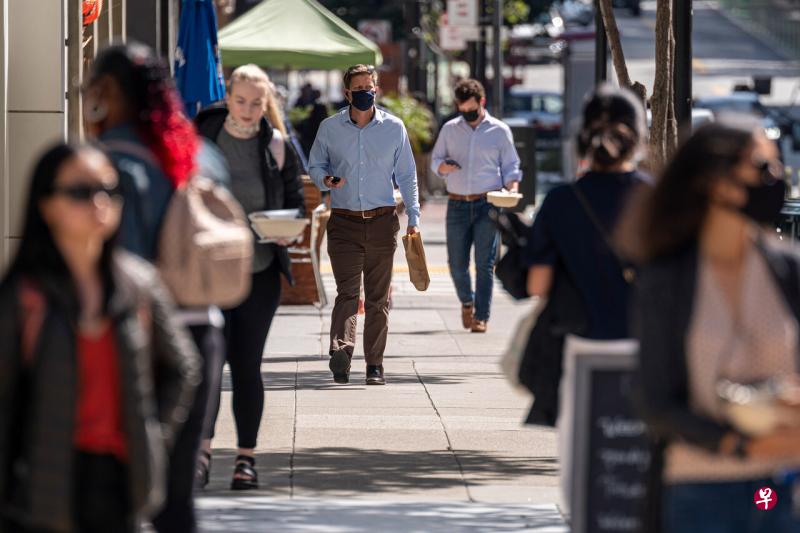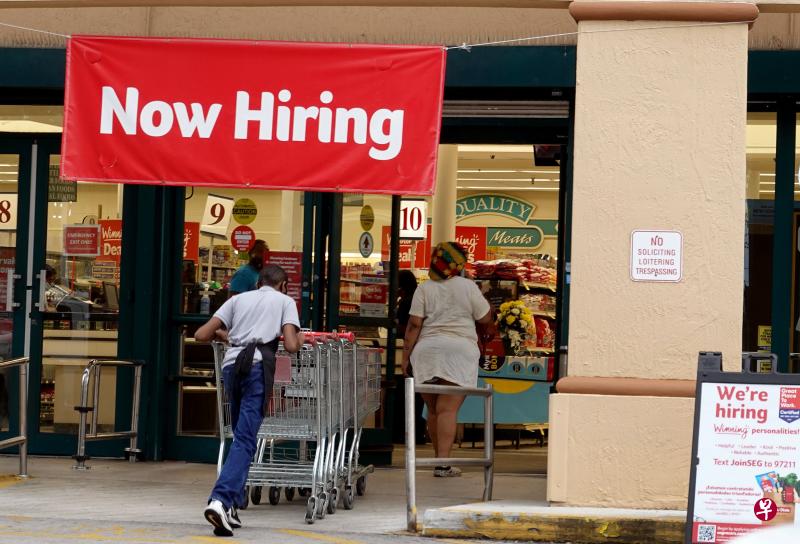数据显示美国企业新增就业人数达到三个月最高
文 / 潘万莉
10/06/2021

(早报讯)美国企业9月新增就业人数超过预期,并创出6月份以来最大增幅,表明随着越来越多的美国人重返工作岗位,持续的招聘困难开始有所缓解。
根据民间就业服务机构ADP研究院周三发布的数据,上个月企业就业人数增加了56.8万人,8月份数据修正后为增加34万人。彭博调查经济学家得出的预期中值为增加43万。

Tel: 551-580-4856 | Email: F.WINNIE.S@GMAIL.COM
招聘步伐加快表明,在联邦补充失业救济金于9月6日结束,并且学校重新开放使一些父母得以重返工作岗位之后,企业填补空缺职位变得更加容易。即便如此,仍需要更多时间才能实现劳动力市场的全面复苏,ADP衡量的总就业人数仍远低于大流行病爆发前水平。
美国劳工部将于周五公布月度就业报告,目前预计美国9月私营部门非农就业人口增加45万。
诚招美国和加拿大法律服务代理
因公司发展需要,诚招美国和加拿大法律服务代理。
要求:
懂英语、或西班牙语、或法语。
能合法工作有社安号或工号。
无需改行, 可以兼职。
大学生和有销售经验优先考虑。
自雇生意公司发美国报税1099,加拿大T4A
有意了解详情, 请扫码加微信, 非诚勿扰!

研究:在疫情期间 美国失业人口约一半没积极找工
文 / 林煇智
9/23/2021

(早报讯)摩根大通一项最新研究显示,美国疫情期间失业人口有大约一半没有积极找工作。尽管美国多个行业面临劳动力短缺,但人们并不急于重返工作岗位。
摩根大通资深经济学家、该报告的作者埃哲顿说:“粗略地说,疫情期间失去工作的人中,约有一半仍在积极寻找工作,而另一半则没有。”
这是对疫情之前和现在的就业情况进行比较后得出的结论。当疫情首次爆发时,美国就业率下降了15%,这意味着2200万个工作岗位被裁掉。
现在,自疫情期间就业率降至最低水平以来,美国新增了约1700万个就业岗位,但要达到疫情前的水平仍然需要增加约550万个就业岗位。据摩根大通称,其中约290万个岗位代表着“劳动力的减少”——意味着这些人已经放弃,不再积极寻找工作。
摩根大通发现,有90万离开劳动力市场的人年龄在55岁或55岁以上,他们可能是受疫情影响而提前退休的人群中的一部分。
堪萨斯城联储的一份报告发现,2020年2月至2021年6月期间,退休人数增加了1.3%,远高于通常0.3%的增幅。有报道称,美国人现在正计划比以往更早退休,新的退休年龄为62岁。
但这意味着200万美国人可能会被吸引回劳动力市场。摩根大通认为,在市场吃紧的情况下,他们“将继续重返就业岗位”。一些人可能会随着他们大流行期间的储蓄——无论是来自刺激支票还是其他联邦支持——的减少而回归。
在空缺职位不断创历史新高、企业为吸引工人回来而提高工资之际,失业率仍居高不下似乎有些矛盾。但造成这种情况的原因有很多,其中之一是儿童保育,随着德尔塔变种病毒的蔓延,学校可能面临关闭。而且,随着工人们离开这个低薪行业,儿童保育行业自身也面临着人力危机,该行业的工人人数比疫情前减少了126,700人。
Only half of the people who lost jobs during COVID are going back to work
By Juliana Kaplan
9/23/2021

Justin Sullivan/Getty Images
- JPMorgan found that half of the people who lost jobs during COVID aren’t looking for a new one.
- Those 2.9 million people who dropped out of the labor force may have retired, or are still waiting to return.
- There’s a number of reasons people aren’t returning, from childcare to expecting more out of a job.
The pandemic is dragging on and people aren’t rushing back to work, despite anecdotes of signing bonuses, the end of federal unemployment benefits, and rising wages. Now, a note from JPMorgan’s Jesse Edgerton shows just how many people haven’t returned.
“Loosely speaking, about half of the people who lost jobs during COVID are still actively looking for work, while the other half are not,” Edgerton writes. That comes from a comparison of pre-COVID employment to today. When the pandemic first hit, employment dropped by 15% — meaning that 22 million jobs were shed.
Now, about 17 million more jobs have been added since pandemic employment hit its lowest, but that still leaves about 5.5 million jobs to go before reaching pre-COVID levels. According to JPMorgan, about 2.9 million of those jobs represent a “decline in the labor force” — meaning that those people have dropped out and aren’t actively seeking employment.
Notably, JPMorgan finds that 900,000 of those who departed the labor force are age 55 or older; they might be part of the flock of early retirees driven by the pandemic. A report from the Federal Reserve Bank of Kansas City found that retirement shot up between February 2020 to June 2021 by 1.3% — well above the usual 0.3% rise. Insider’s Ben Winck reported that Americans are now planning to retire earlier than ever, with the new retirement age coming in at 62.
But that means that 2 million Americans could be lured back into the labor force, and JPMorgan believes that they “will continue to drift back into employment” in the midst of a tight market. Some may return as their pandemic savings — whether from stimulus checks or other federal support — dwindle.
It may seem paradoxical for unemployment to remain high as job openings continue to reach record highs and wages rise to lure back workers. But there’s a number of reasons that holes remain. One of them is childcare, with schools facing potential closures as the Delta variant spreads. And, as The Washington Post’s Heather Long reports, childcare is facing its own staffing crisis, as workers leave the low-paying industry — and the industry sees 126,700 fewer workers than pre-pandemic.
Women over the age of 20, who already had a lower labor force participation than men, were particularly pummeled by pandemic caregiving responsibilities. In August, the labor force participation rate for those women actually dropped from the month prior, indicating yet another impact of the Delta variant.
The current shortages are likely driven in part by what economists call mismatches. That means there may be a disconnect between the skills applicants have and the jobs that are available (or employers’ hiring software are filtering out people who may have relevant, but not word-for-word necessary skills).
Workers have also shown that they want more from work, leaving industries like leisure and hospitality en masse and quitting in record-breaking numbers for four months in a row.
Delta variant fears are deterring Americans from seeking work
BY AIMEE PICCHI
8/30/2021
As the U.S. economy continues to rebound, some employers are struggling to hire workers, forcing restaurants to shutter dining rooms or cut hours. Potential causes of the worker shortage have sparked no end of debate. Some blame generous unemployment benefits, while others point to a lack of child care and early retirements.
Now there’s another twist that could deter Americans from seeking work: Renewed fear over contracting or spreading COVID-19 as the Delta variant sparks outbreaks, including breakthrough cases, across the nation. About 3.2 million Americans told the Census Bureau that they weren’t employed from between August 2 and August 16 because of concerns about the virus, up 30% from the previous polling period over the last two weeks of July.
To be sure, that’s only a small share of the overall ranks of unemployed Americans, who amounted to more than 100 million as of the most recent Census survey. The bulk of those without jobs — more than 42 million people — said they were retired, according the survey. But the number of people staying out of the job market due to COVID-19 anxiety now exceeds the 2.5 million people who said they aren’t working because their employer closed temporarily due to the pandemic.
Spike in people who say they’re not working due to fears of COVID -19
More than 3.2 million people say they aren’t working because they are worried about getting or spreading the virus, an increase of 30% from mid-July. These states had the biggest increase in people sitting out the labor market for that reason.
That may not bode well for the recovering labor market, with economists warning that the Delta variant could pose a threat to job growth. Bank of America analysts on Friday forecast that employers added 600,000 workers to their payrolls in August, which would be down sharply from 943,000 in July.
“The softening in employment activity would be consistent with other economic data that have weakened since the surge in COVID case counts due to the Delta variant,” they wrote.
The U.S. Department of Labor will release its next employment report on September 3, providing more data on the state of the job market and the Delta variant’s impact on specific regions. For instance, the number of COVID-fearful workers sitting out the job market spiked sharply in states with rising cases. In Florida, where the COVID-19 death rate has reached an all-time high, the number of jobless workers waiting out the pandemic has tripled.
Illinois witnessed the largest percentage increase of people exiting the job market due to pandemic fears, with numbers rising more than sevenfold, from about 19,000 people in July to 144,000 in early August, Census data show. Illinois Governor J.B. Pritzker on Thursday said all residents will be required to wear a mask indoors regardless of vaccination status.
On the flip side, Vermont — the most vaccinated state in the nation — had a negligible number of people who said they weren’t working due to coronavirus concerns, the Census data showed.
Small businesses worried
Other signs highlight the Delta variant’s impact on the economy. Small business owners are increasingly pessimistic about the economic recovery, according to a new analysis of Census data from the Economic Innovation Group (EIG).
“After improving from February to May and stabilizing through the summer, recovery expectations took a turn for the worst in August,” noted Kennedy O’Dell, a research and policy associate at the research firm, in a blog post.
The share of small businesses expecting it will take at least six months to return to normal rose seven percentage points, from about 32% in mid-July to 39% in mid-August, EIG said. One in 10 businesses said they don’t believe their operations will ever return to normal, the highest share since June 2020, O’Dell added.
Meanwhile, consumer spending slowed in July to a modest increase of 0.3%, a sign some Americans are cutting back as COVID-19 rates increase. That includes travelers, who are canceling flights amid the surge in COVID-19 cases. The Transportation Security Administration this week reported its lowest air travel numbers of the summer on Tuesday and Wednesday, a sharp reversal after hitting its peak this year at the beginning of August.




